The Reed Street Yards is Worth the Investment

Reed Street Yards
“It has been vacant for decades,” said Dan Casanova, of the Department of City Development.
The 17-acre property known as the Reed Street Yards is located between South 6th Street and South 3rd Street just across from the Harley-Davidson Museum in Walker’s Point. This property has been targeted by the City of Milwaukee as the potential epicenter of Milwaukee’s water industry. The property itself, despite being centrally located, has sat vacant for years, and currently has no infrastructure, such as roads and sewers that are necessary to support future development. At Tuesday’s Zoning, Neighborhoods & Development meeting the Department of City Development presented a project plan to construct the infrastructure and put in place the pieces need to develop this land. Rocky Marcoux, Commissioner Department of City Development, laid out the issue quite clearly saying “I’ll never have the opportunity to make the sale, if I don’t have something to sell.”
The re-development of the Reed Street Yards is the next piece of the puzzle to the revitalization of Walker’s Point, but more importantly it is the first physical effort by the City of Milwaukee to embrace the world water capital vision as laid out by the M7. At the meeting Alderman Robert Bauman referred to the proposal as “speculative,” and surely there is a level of risk as there is with any project, but it is time for Milwaukee to get serious about becoming the world water capital, and this is a first step.

















This is precicely the kind of project that the TIF law was created for. It would create new jobs (rather than transplant exsisting jobs from other parts of the city) add to the City’s tax base in the long run and feature public amenities. It would be a huge step forward for the Menomonee Valley and I hope it gets done.
i totally support this. it’s nice to see something other than condos being proposed for the area. the more stable, non-service jobs we can get into the neighborhood the better as far as i’m concerned.
First off, I must say that I’m completely in favor of creating a new Milwaukee, spearheaded by the growing water technology industry. But why is this area deemed best for water-related industry? Because it’s available, it’s size and it’s central location? The river channel goes through the site, but it seems there are other areas that have all the same qualities and then some. I’m thinking of the area between UWM’s Great Lakes Institute and where Rivianna is proposed. It’s virtually a blighted wasteland in between and has waterfront that is directly on the port ( and a mere hundred yards from the lake. Creating a water-related industrial park near UWM’s current presence could spur them to develop their Freshwater Science school in that area as well. I only bring this up because then all the water-related schools would then be right near the water-related industries. Or many of them at least. Seems these separate initiatives should be planned with each need in mind, thus leading to greater success for both to feed off each other.
@c:
I agree that the area that you’re referring to would be an ideal site for water related businesses. But there are so many different landowners in that area, it would take the City years to piece together land deals to make something happen there. There are still a number of functioning businesses there (such as boat storage businesses) that would have to be taken by the City for clearing.
The Reed Street Yards site is totally empty (no displacement issues) and has one owner who is ready, willing and able to get started on something. It’s a clean slate, a large contiguous site, making it more accomidating to businesses with varying space needs.
I guess what I’m saying is South Water Street in an ideal world would be great as a water hub, but Reed Street Yards is more feasible right now, and a pretty fantastic setting for water related businesses, to boot.
I prefer the school to be located on the lakefront, but this would work too. Reed St. Yards is a very interesting site for development.
@Doug To be clear this site isn’t about the School of Freshwater Sciences. This site is primarily to recruit water related business operations.
ah! I have completely gotten all this freshwater talk mixed up, my bad.
@Doug I should add it is possible the school could end up there, or well a bunch of places, but that is still very unclear.
Are there any other uses planned for this site or is it intended to be more of a downtown research park? I vaguely remember talk of extending the street grid and connecting the site to the surrounding area. I guess in either case it’s still a positive step forward.
@KS Yes the street grid will connect through to the tannery complex on the other side
A bit unrelated, but not totally… I was thinking about this area of Milwaukee (most specifically all the old abandoned buildings) when I was in Beijing a few weeks ago. Beijing has a place called the “art district” that is about four or five square blocks in size. It was formally a sprawling electronics / weapons factory complex, but now contains probably one hundred art galleries / studios and several cafes (Google this place!). Anyway, it seemed that the financial investment in the “art district” area was minimal as most of the buildings still contained industrial ductwork, old rusted windows, unfinished walls / floors, etc… yet it is now a very interesting / vibrant part of the city.
I don’t know much about the Milwaukee art community, or if there would be environmental issues… but I thought perhaps a similar project could be undertaken to turn this somewhat blighted area of Milwaukee into something interesting (without spending large amounts of money to tear these buildings down or remodel them into living / office space)… just an idea.
In my opinion, Reed Street Yards presents a critical opportunity at a distinct moment in time for Milwaukee. For all the reasons previously noted, it is a realistically developable parcel that is well positioned to be leveraged for water-related economic development. Action at Reed Street Yards now will link to the planned redevelopment of S. 2nd Street and build on the momentum of recent investments made by Ann Pieper at the Everitt Knitting redevelopment and Tim Dixon at Iron Horse hotel. We will help ensure the viability of those developments by continuing these related efforts.
The recent Common Council (ZND) Committee hearing on Reed Steet Yards TIF suggested that alderman will take issue with how the Department of City Development is proposing to approach this. Concern was raised about investing such significant public infrastructure for, what they described as the direct benefit of one owner. Suggestions were made to either have the owner take more responsibility directly for these improvements first or that the City pursue an acquisition strategy – much like at Tower Automotive – to completely control the site. As a business owner in the area, I could also certainly cry foul and agree with the aldermen, since I am not getting the same direct investments for my properties, but I think that would be incredibly narrow thinking. This strikes me as exactly the type of opportunity TIF was designed for and a smart strategy to approach it by the Department of City Development. That said, I would be interested to know what other UM readers think about these aldermanic objections. They will likely become substantial potential obstacles in the way of the eventual Common Council approval necessary to allow the project to proceed. I think robust debate on their concerns can help further clarify the issues and get us to the best outcome.